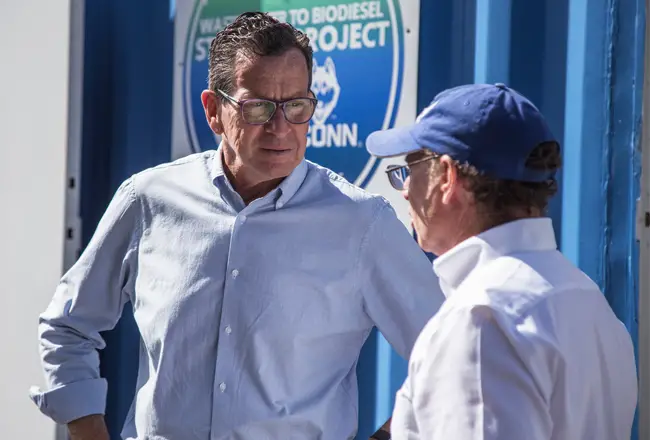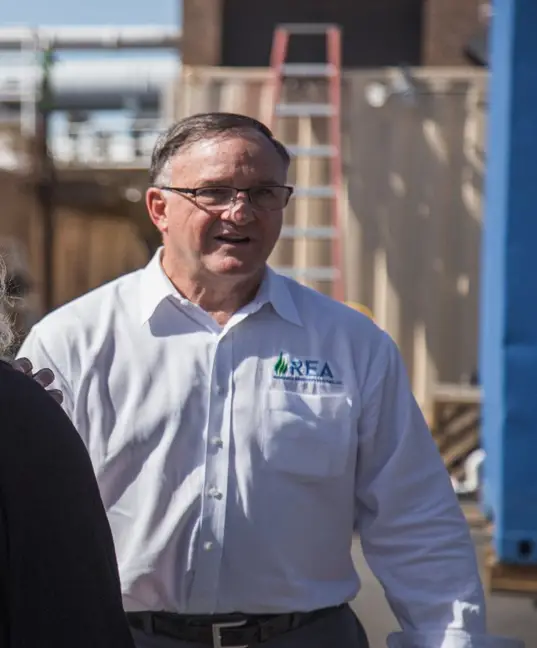REA Resource Recovery Systems and UConn join to create biodiesel from wastewater
Petroleum power brokers may consider the subject of their devotion liquid gold, but the environmentally conscious are coming to believe that there may be gold in used grease as well.
Trumbull”™s REA Resource Recovery Systems is working with the University of Connecticut and the Greater New Haven Water Pollution Control Authority on a project that turns such waste ”” called “Brown FOG” (fats, oils and grease) ”” into biodiesel fuel. Last month REA demonstrated its fatty acid reactor for Gov. Dannel Malloy at the East Shore Water Pollution Abatement Facility in New Haven.


“It”™s a huge problem, both in the United States and internationally,” said REA Operations Manager Eric Metz. “And with population growth increasing, there”™s going to be more Brown FOG going into the sewer systems,” which can result in overflows and blockages that can be expensive to fix.
“Federal regulations say that any grease pumped out has to go to a wastewater treatment system,” Metz said. “What we”™re doing is helping them to treat it and turn it into biodiesel.
“We have to handle and get rid of it,” Metz continued. “Studies have shown that there”™s somewhere between 1.5 (billion) to 2 billion gallons of brown grease in wastewater in the U.S. and possibly two times that internationally.
“We believe that our technology is a good fit for wastewater facilities,” he said. “This way there are no disposal costs and the resulting product can be used for power generation, including fuel for their own tractors and trucks.”
Playing a key role in the project is Richard Parnas, a professor in the Department of Chemical & Biomolecular Engineering at UConn. “In the summer of 2007, on the very last day of class, I was approached by an undergraduate student who presented the idea of using one of our labs to create biodiesel,” he said. “That was the first I”™d ever heard of biodiesel.”
Work soon commenced with the aim of converting the waste vegetable oil from UConn”™s restaurants and dining halls into biodiesel.
The resulting reactor proved viable in converting that oil ”” “yellow grease” ”” into biodiesel. The next step, Parnas said, was to look at Brown FOG, which is “of much lower quality, dirtier ”” it”™s kind of disgusting.”
Al Barbarotta ”” CEO of Bridgeport-based AFB Construction Management, a city schools contractor that works with the school systems in Trumbull, Stamford, New Haven and East Haven ”” said he was introduced to Parnas and Metz a few years ago by then-Stamford Public Works Director Alex Tergis. “They were looking for some help with the business end of what they were trying to do and I eventually agreed to get involved,” Barbarotta said.
With an investment of $1 million and the formation of REA last November, Barbarotta was able to fund the reactor invented by Parnas, whose three patents are owned by UConn and exclusively licensed by REA. Under a license agreement with UConn, the school will earn royalties from the use of the reactor by wastewater treatment plants.
REA”™s equipment has been used by the water pollution control authority to teach UConn students the basics of industrial production of biodiesel from brown grease. The students learned aspects of automatic process control, chemical conversion technology, liquid-based separations, distillation and quality control.
At the water pollution control authority, the students conducted process runs of the equipment under the supervision of Parnas, Metz and facility personnel. Collected samples have been analyzed by UConn students for sulfur content, completion of chemical conversion, and several other product characteristics necessary to establish the success of the project.
Some of the analytical methods were set up at the facility for real-time analysis of the produced biodiesel, while the more complex analyses will be conducted at UConn on specialized equipment.
The demonstration for the governor was designed to create 150,000 to 200,000 gallons of biodiesel, Barbarotta said. The end product is rated B100 ”” pure biodiesel ”” which typically sells for around $4 per gallon.
However, Parnas noted, the potential is there to produce 2.5 billion to 3 billion gallons of B100 a year”” a number that could double down the line.
In addition, Parnas said that the ultimate goal is to wean wastewater treatment plants from the grid.
“Right now they use about 5 percent of the total electricity production in the U.S.,” Parnas said. “If they instead use this system to produce biodiesel, which can be used for electric power, we can take the wastewater treatment industry off the grid completely and free that up.”
Such an occurrence would be the process”™s “ultimate potential,” Parnas said. “But that”™s still a long way down the road.”
REA has targeted four potential Brown FOG receiving plants ”” in Danbury, Hartford, New Haven and Waterbury ”” to move the project forward, said Barbarotta, who added that he hoped to enter into formal discussions “real soon.”
UConn students have continued working on a part-time basis on the system. “We”™re still doing research and laying the groundwork,” Barbarotta said, “but eventually we hope to hire them to work for us once they graduate.”